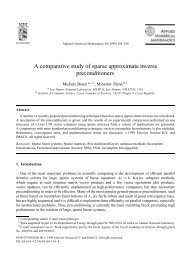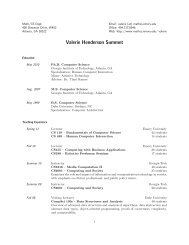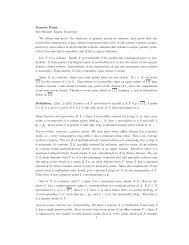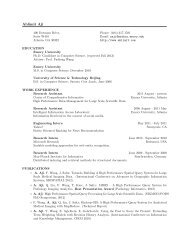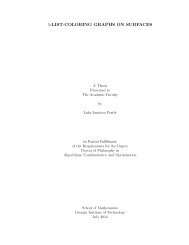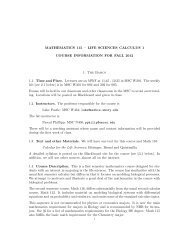Chapter 3 Solution of Linear Systems - Math/CS
Chapter 3 Solution of Linear Systems - Math/CS
Chapter 3 Solution of Linear Systems - Math/CS
You also want an ePaper? Increase the reach of your titles
YUMPU automatically turns print PDFs into web optimized ePapers that Google loves.
50 CHAPTER 3. SOLUTION OF LINEAR SYSTEMS<br />
By transferring the terms involving the <strong>of</strong>f-diagonal entries <strong>of</strong> A to the right hand side we obtain<br />
a1,1x1<br />
= b1<br />
a2,2x2 = b2 − a2,1x1<br />
a3,3x3 = b3 − a3,1x1 − a3,2x2<br />
Observe that the right hand sides can be divided naturally into rows and columns. Row—oriented<br />
forward substitution evaluates the right hand side one row at a time, while column–oriented forward<br />
substitution evaluates the right hand side one column at a time. Pseudocodes implementing rowand<br />
column–oriented forward substitution are presented in Fig. 3.4. Note that:<br />
• The “equations” in the algorithms are not intended to make mathematical sense. The symbol<br />
“:=” means assign the value <strong>of</strong> the right hand side to the variable on the left hand side.<br />
• The “for” loops step in ones. So, “for i = 1 to 3 means execute the loop for each value i = 1,<br />
i = 2 and i = 3, in turn. (Later, in Figures 3.6 and 3.9 we use “downto” when we want a loop<br />
to count backwards.) When a loop counting forward has the form “for j = 1 to i − 1” and<br />
for a given value <strong>of</strong> i we have i − 1 < 1 then the loop is considered to be empty and does not<br />
execute for any value <strong>of</strong> j. A similar convention applies for empty loops counting backwards.<br />
• The algorithm destroys the original entries <strong>of</strong> b. If these entries are needed for later calculations,<br />
then they must be saved elsewhere. In some implementations, the entries <strong>of</strong> x are written over<br />
the corresponding entries <strong>of</strong> b.<br />
The corresponding algorithm for a general lower triangular system <strong>of</strong> order n is given in Figure 3.5<br />
Problem 3.1.8. Why is a diagonal linear system also a lower triangular linear system?<br />
Problem 3.1.9. Consider a general lower triangular linear system <strong>of</strong> equations <strong>of</strong> order n. What<br />
are the conditions on the entries <strong>of</strong> its coefficient matrix so that its solution can be determined by<br />
each <strong>of</strong> the forward substitution pseudocodes?<br />
Problem 3.1.10. Illustrate the operation <strong>of</strong> column–oriented forward substitution when used to<br />
solve the lower triangular linear system in Fig. 3.1(b). Hint: Show the value <strong>of</strong> b each time it has<br />
been modified by the for-loop and the value <strong>of</strong> each entry <strong>of</strong> x as it is computed.<br />
Problem 3.1.11. Use the row–oriented version <strong>of</strong> forward substitution to solve the following linear<br />
system <strong>of</strong> order 4.<br />
3x1 + 0x2 + 0x3 + 0x4 = 6<br />
2x1 + (−3)x2 + 0x3 + 0x4 = 7<br />
1x1 + 0x2 + 5x3 + 0x4 = −8<br />
0x1 + 2x2 + 4x3 + (−3)x4 = −3<br />
Problem 3.1.12. Repeat the previous problem but this time using the column–oriented version <strong>of</strong><br />
forward substitution.<br />
Problem 3.1.13. Modify the row– and the column–oriented pseudocodes in Fig. 3.5 for forward<br />
substitution so that the solution x is written over the right hand side b.<br />
Row-Oriented Column-Oriented<br />
for i = 1 to n for j = 1 to n<br />
for j = 1 to i − 1 xj := bj/aj,j<br />
bi := bi − ai,jxj<br />
for i = j + 1 to n<br />
next j bi := bi − ai,jxj<br />
xi := bi/ai,i<br />
next i<br />
next i next j<br />
Figure 3.5: Pseudocode Row- and Column-Oriented Forward Substitution, general n.



